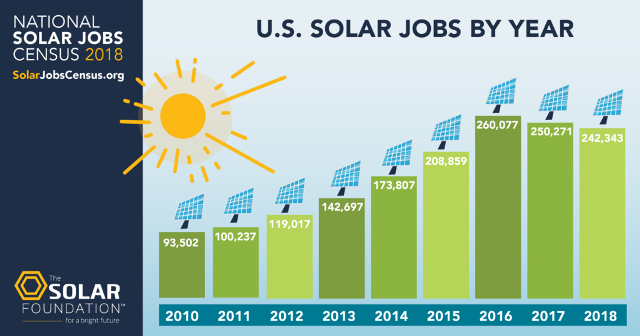The number of jobs in the US solar industry dropped 3.2 percent in 2018, according to a new report from The Solar Foundation.
The number of solar energy workers fell by 8,000 to 242,000 in 2018, according to the Solar Jobs Census, released by research firm The Solar Foundation. US solar jobs dropped 10,000 in 2017.
The United States has 242,343 solar workers, defined as those who spend 50 percent or more of their time on solar-related work, the report on solar jobs said.
The solar workforce has grown 159 percent since the first Census was released in 2010, adding nearly 150,000 jobs.
Solar jobs rose in 29 states in 2018, including many states with emerging solar markets. States with the highest employment gains include Florida, Illinois, Texas, and New York State.
The second year of job losses is due to the Donald Trump administration’s tariffs on foreign panels and state-level policy changes hit demand for installations.
Solar jobs are expected to rise next year, the report said. The Solar Foundation said it expects a rebound in jobs of 7 percent next year, however, due to recent declines in solar panel prices that have made them more affordable.
With a backlog of utility-scale projects and new policy incentives in key states, the outlook for solar jobs is expected to improve in 2019. Survey respondents predict that solar jobs will increase 7 percent in 2019, bringing the total to 259,400 jobs.
The job losses reflect how changing trade and environmental policies can alter the trajectory of an industry that was among the fastest-growing segments of the U.S. energy industry, Reuters reported.
In early 2018, President Donald Trump imposed 30 percent tariffs on imported solar panels to boost domestic manufacturing, the opening salvo in what has become a wide-ranging trade war. The move led developers to cancel or freeze billions of dollars of investments in large-installation projects because most of the solar panels used in the United States are made abroad.
Jobs in the solar industry’s manufacturing sector – a small slice of the overall industry – fell 8 percent in 2018.
Policies of US states are also critical to solar growth, and changes in incentives and rates for projects in large markets led to job losses there.
In California, utility procurement slowed because power companies have fulfilled near-term renewable energy procurement requirements. The state’s commercial market also slowed due to a shift to rates that are less favorable to solar.
In Massachusetts, the commercial market stalled ahead of the introduction of a new incentive scheme at the end of the year.
China last year slashed subsidies for solar installations, bringing low-cost Chinese-made panels onto the international market and pushing prices below what they were before the tariffs were imposed.
Installation will receive the biggest bump, more than 9 percent, while manufacturing will rise 4 percent.
JinkoSolar Holding, Hanwha Q CELLS, and some others are opening U.S. factories to avoid US tariffs.

